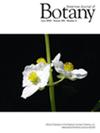Cretaceous and Paleocene fossils reveal an extinct higher clade within Cornales, the dogwood order
Abstract
Premise
Characterization and phylogenetic integration of fossil angiosperms with uncertain affinities is relatively limited, which may obscure the diversity of extinct higher taxa in the flowering plant tree of life. The order Cornales contains a diversity of extinct taxa with uncertain familial affinities that make it an ideal group for studying turnover in angiosperms. Here, we describe a new extinct genus of Cornales unassignable to an extant family and conduct a series of phylogenetic analyses to reconstruct relationships of fossils across the order.
Methods
Two permineralized endocarps were collected from the Cedar District Formation (Campanian, 82–80 Ma) of Sucia Island, State of Washington, United States. Fossils were sectioned with the cellulose acetate peel technique and incorporated into a morphological dataset. To assess the utility of this dataset to accurately place taxa in their respective clades, we used a series of phylogenetic pseudofossilization analyses. We then conducted a total-evidence analysis and a scaffold-based approach to determine relationships of fossils.
Results
Based on their unique combination of characters, the fossils represent a new genus, Fenestracarpa washingtonensis gen. nov. et sp. nov. Pseudofossilization analyses indicate that our morphological dataset can be used to accurately recover taxa at the major clade to family level, generally with moderate to high support. The total-evidence and scaffold-based analyses recovered Fenestracarpa and other fossil genera in an entirely extinct clade within Cornales.
Conclusions
Our findings increase the reported diversity of extinct Cornales and indicate that the order's initial radiation likely included the divergence of an extinct higher clade that endured the end-Cretaceous Mass extinction but perished during the Cenozoic.

 求助内容:
求助内容: 应助结果提醒方式:
应助结果提醒方式:


